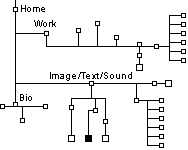
|
||||
|
Bernice Murphy, Prismatic realities: an introduction to Anna Oppermann, in brochure: Paradoxical Intentions, Sydney 1994 |
Although she began as an academically trained painter, and indeed retained immensely refined abilities as a painter throughout her career as an artist, the ensemble - as an enveloping mode of production and vision - is what distinguishes Anna Oppermann's mature work. The ensemble provided persistent structural impulses within her work's evolving character and particularity over two and a half decades.
The ensembles evolved from a foundational corner-format of a domestic interior. They developed originally from a photographic view, taken of small still-life notations - in drawings and objects - in situ near a window, in her apartment in Hamburg. The ensembles became ever more layered in time, as well as in spatial complexity and formally differentiated but interconnecting elements. There were always crucial aspects leading beyond technical considerations, however, in the emergence of the installational format in Anna Oppermann's work. These had to do with the articulation of a particular psychological and philosophical complexity in her rendition of the world, rather than the mere deployment of informal materials and heterogeneous elements in a novel way.
It is important to stress that, around 1968 (at a time when the idea of feminist concerns in art faced the most severe challenges in the German art establishment) Anna Oppermann began to work in a specific way with the domestic interior. Ideas of the personal and social identities of women, as well as intimate objects around her, provided much of Oppermann's subject matter. She worked with an intense exploration and inwardness (in fact in her own living space of the kitchen, with a young child nearby) as a context for definition of the crucial elements of self-identity, daily work, personal and social relations.
Through this precisely explored, domestic context, she undertook a difficult task of accumulating and articulating these relations in her work, by means of overlapping imagery in which the images and physical elements jostle and converge, and at the same time disturb and refract apart from each other. Anna Oppermann also engaged a larger framework of ideas. Her analysis moved outwards, towards a quite profound dimension of defining the larger world and its scaffolding of concepts, categories, histories and determining forces - as these structure the life, and the intellectual and cultural landscape, of an individual.
Although these themes were not yet used as specific titles for installations, which began to emerge in the public sphere as fully defined ensembles in the early 1970s, a generalisation and abstraction of the philosophical undercurrent of her works did emerge as a theme by the mid-1970s. For example,
It is important to emphasize, however, that Anna Oppermann always viewed political art - and especially the traps of utopianism or didacticism - with the utmost caution. As her work progressed, and increased in scale and complexity, her installations developed the political and economic aspects more overtly - often augmented by texts that interlaced the social cross-threading of her subject matter. However the personal and the universal were always sought as constantly interpenetrating possibilities in all of Oppermann's thematising of social or political materials. She had an unswerving disdain for an over-determined, programmatic approach to the complexity of the political and social potential of art.
Another important component of the earliest installation works of Anna Oppermann - and philosophically inflecting their strands of perception and meaning - arose through the use of the mirror. 'For me the mirror - the breaching of the borders of reality - was a key experience', the artist stated in 1984.
The text that follows in this catalogue, written especially for the exhibition by Ines Lindner, an art historian in Berlin, goes on to discuss the prismatic, oscillating effects of physical encounter and meaning in Anna Oppermann's work in greater depth, through detailed discussion of the installation,
The installation for Sydney, while being able to be viewed as a detachment, complete in itself, should also be understood in its open-ended character, in its itineraries of connection to a more complex history: the history of Anna Oppermann's work, and of her links to the larger social and intellectual body of German (and European) art as she experienced these in her lifetime. To gain its full meaning, therefore, this installation seeks ultimately to be reunited to the enveloping, multifaceted project that was Anna Oppermann's life's work as an artist.
Notes:
(1)
[